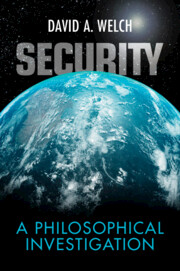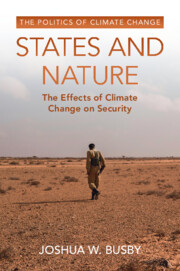Refine search
Actions for selected content:
38 results
8 - Human Security
- from Part I - Security in Theory
-
- Book:
- Understanding International Security
- Published online:
- 11 October 2025
- Print publication:
- 30 October 2025, pp 155-168
-
- Chapter
- Export citation

Understanding International Security
- Theory and Practice
-
- Published online:
- 11 October 2025
- Print publication:
- 30 October 2025
-
- Textbook
- Export citation
23 - From International Legitimacy to Global Justice
- from Part VI - Criticism and Reconstruction of the Legitimacy of International Law
-
- Book:
- The Law and Politics of International Legitimacy
- Published online:
- 14 July 2025
- Print publication:
- 24 July 2025, pp 462-487
-
- Chapter
- Export citation
8 - The Ontological Weight of Human Security
- from Part III - Struggling for Positive Human Development
-
- Book:
- Global Crisis and Insecurity
- Published online:
- 01 June 2025
- Print publication:
- 12 June 2025, pp 183-205
-
- Chapter
- Export citation
The Emptiness of Japan's Values Diplomacy in Asia
-
- Journal:
- Asia-Pacific Journal / Volume 18 / Issue 19 / October 2020
- Published online by Cambridge University Press:
- 14 March 2025, e1
-
- Article
-
- You have access
- Open access
- Export citation
Post-COVID, Digital Societies: Opportunities and Policy Challenges for Human Security in the United Kingdom and South Korea
-
- Journal:
- Social Policy and Society , First View
- Published online by Cambridge University Press:
- 24 February 2025, pp. 1-16
-
- Article
-
- You have access
- Open access
- HTML
- Export citation
Climate change and human security in coastal regions
-
- Journal:
- Cambridge Prisms: Coastal Futures / Volume 2 / 2024
- Published online by Cambridge University Press:
- 12 February 2024, e5
-
- Article
-
- You have access
- Open access
- HTML
- Export citation
4 - The Constitution of China and International Law
- from Part II - Interfaces between National and International Law
-
-
- Book:
- The Cambridge Handbook of China and International Law
- Published online:
- 04 January 2024
- Print publication:
- 18 January 2024, pp 73-93
-
- Chapter
- Export citation
Ten new insights in climate science 2022 – CORRIGENDUM
-
- Journal:
- Global Sustainability / Volume 6 / 2023
- Published online by Cambridge University Press:
- 05 January 2023, e1
-
- Article
-
- You have access
- Open access
- HTML
- Export citation
9 - Intervention and Human Security
-
- Book:
- Fundamental Perspectives on International Law
- Published online:
- 23 November 2022
- Print publication:
- 15 December 2022, pp 494-543
-
- Chapter
- Export citation
Ten new insights in climate science 2022
-
- Journal:
- Global Sustainability / Volume 5 / 2022
- Published online by Cambridge University Press:
- 10 November 2022, e20
-
- Article
-
- You have access
- Open access
- HTML
- Export citation
Introduction
-
- Book:
- Security
- Published online:
- 18 August 2022
- Print publication:
- 25 August 2022, pp 1-9
-
- Chapter
- Export citation
6 - Human Security
-
- Book:
- Security
- Published online:
- 18 August 2022
- Print publication:
- 25 August 2022, pp 159-190
-
- Chapter
- Export citation

Security
- A Philosophical Investigation
-
- Published online:
- 18 August 2022
- Print publication:
- 25 August 2022
Casting a Legal Safety Net: A Human Security Approach to Assisting Families Following Armed Conflict
-
- Journal:
- Israel Law Review / Volume 55 / Issue 3 / November 2022
- Published online by Cambridge University Press:
- 17 August 2022, pp. 215-247
-
- Article
-
- You have access
- Open access
- HTML
- Export citation
12 - Bits and “Peaces”
- from Part IV - Reflections and Research Notes
-
-
- Book:
- Cyber Peace
- Published online:
- 21 April 2022
- Print publication:
- 05 May 2022, pp 212-222
-
- Chapter
-
- You have access
- Open access
- HTML
- Export citation

States and Nature
- The Effects of Climate Change on Security
-
- Published online:
- 03 March 2022
- Print publication:
- 24 March 2022
A Human Security Angle of Conflicts: The Case of Farmer–Herder Conflict in Ghana
-
- Journal:
- International Annals of Criminology / Volume 60 / Issue 1 / March 2022
- Published online by Cambridge University Press:
- 05 April 2022, pp. 62-78
- Print publication:
- March 2022
-
- Article
- Export citation
2 - Climate Security Discourses
-
- Book:
- Ecological Security
- Published online:
- 10 September 2021
- Print publication:
- 23 September 2021, pp 44-93
-
- Chapter
- Export citation
1 - A Proposal for a Kantian Definition of Terrorism
- from Part I - The Globalization of Anti-Terrorism Law: Theoretical Frameworks
-
-
- Book:
- 9/11 and the Rise of Global Anti-Terrorism Law
- Published online:
- 01 July 2021
- Print publication:
- 15 July 2021, pp 15-33
-
- Chapter
- Export citation
